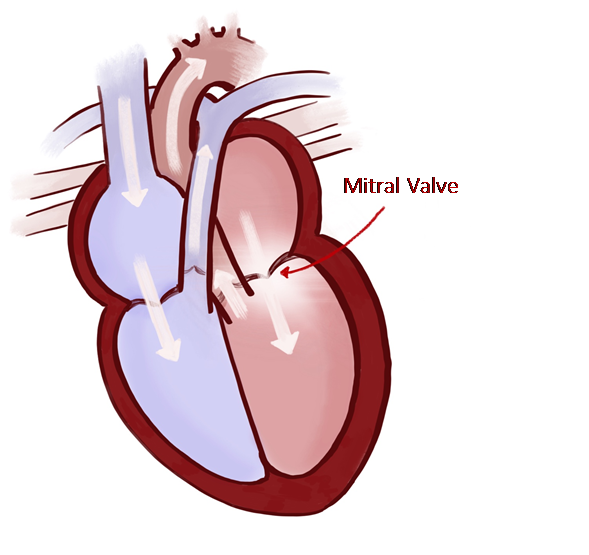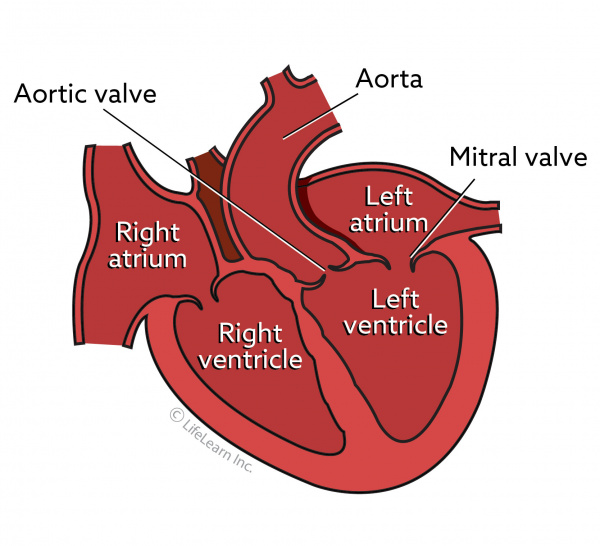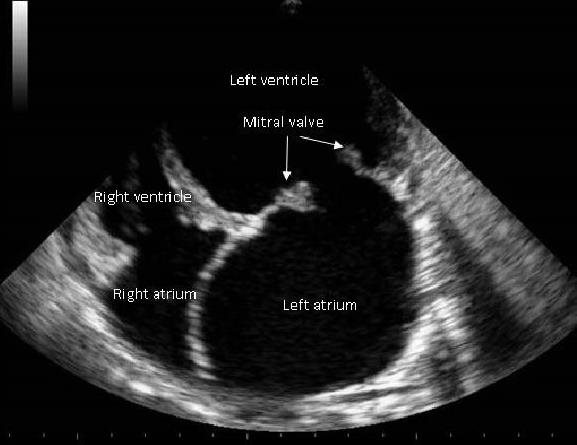Mitral Valve Disease in Dogs
What is the mitral valve?
The heart has four chambers. The upper chambers are called atria (the right atrium and left atrium) atria and the lower chambers are called ventricles (right ventricle and left ventricle). The heart is also divided into right and left sides.
Each chamber of the heart has a one-way valve to keep blood from flowing backward. The valve between the left atrium and left ventricle is called the mitral valve.
How does blood flow through the heart?
Unoxygenated blood returns from the body to the heart by entering the right atrium and then pumped into the right ventricle. The right ventricle pumps blood into the lungs where it picks up oxygen. Oxygenated blood flows from the lungs into the left atrium before flowing into the left ventricle. From the left ventricle, oxygen-rich blood is pumped throughout the body.
What causes mitral valve disease?
Because of the high pressure created when the left ventricle contracts and pumps blood out to the body, the mitral valve may begin to ’wear out’ and leak over time. This is known as mitral valve insufficiency (MVI) or mitral regurgitation and is often associated with a heart murmur. Other causes of mitral valve insufficiency include ruptured chordae tendinae, a condition in which the fibrous cords that hold the valve leaflets in position break, and heart valve infections known as endocarditis. Endocarditis may result from blood-borne infections or, more commonly, may be secondary to chronic oral infections (periodontal disease).

How common is mitral valve disease?
Approximately one in ten dogs (10%) will develop some form of heart disease during their lifetime, and approximately 80% of the heart disease is due to mitral valve insufficiency. MVI is more common in small dogs than large breeds.
What are the signs of mitral valve disease? What are the consequences of it?
The earliest sign of a leaking mitral valve is normally a heart murmur. This is produced by the turbulence created when some of the blood goes backward through the leaking mitral valve into the left atrium. Dogs may develop a murmur from a leaking mitral valve as early as four to six years of age.
Initially, MVI is asymptomatic (produces no obvious clinical signs). As time progresses, the regurgitation becomes more severe and as more blood flows back into the atrium, the heart's efficiency is reduced. Eventually, congestive heart failure develops. From the time a murmur develops, it may be a few months to several years until heart failure occurs.
A heart murmur does not mean that heart failure is imminent, but eventually congestive heart failure will occur. Dogs with a heart murmur do have an increased risk of sudden death.

When I took my dog for his annual health examination, my veterinarian told me he had a mitral murmur but said he was not going to treat it at this stage. Is this correct?
Veterinary cardiologists differ in when they recommend medical intervention for asymptomatic heart murmurs. Newer drugs such as carvedilol may have cardio-protective benefits in dogs similar to those demonstrated in humans. Spironolactone may also have some protective benefits by reducing the workload the heart is under and may slow down the progression of heart disease. Your veterinarian will carefully evaluate your pet's condition and lifestyle and make the best treatment recommendations to preserve health and vitality.
How will I know if my dog has heart failure?
When the left side of the heart is not properly pumping blood, the blood slowly backs up in the lungs. This results in small amounts of fluid leaking out of the capillaries into the air passageways. This fluid collection produces the earliest signs of heart failure that include gagging as if trying to clear the throat, a chronic, hacking cough, and lack of stamina (your dog will tire more easily on walks). Dogs with heart failure are usually sick whereas dogs with heart murmurs may have few, if any, clinical signs until heart failure develops.
The degree of clinical signs is directly related to the amount of decreased blood flow that is occurring. This is why early diagnosis and treatment is essential in slowing the progression of heart failure.

What happens in congestive heart failure?
Congestive heart failure begins when the heart is unable to provide the tissues with adequate oxygen and nutrients. Without adequate oxygen, the body's cells become distressed and trigger a series of responses. Various hormones are released in an attempt to increase blood oxygen levels and blood circulation. These hormones conserve fluid in an effort to increase blood volume and the output of blood and oxygen by the heart. For several months, these compensatory responses help the situation and the dog has few observable clinical signs.
Eventually the increased fluid retention becomes a detriment as more and more fluid leaks out of capillaries and into the lungs, abdomen, and other body tissues. Fluid in the lungs is called pulmonary edema, fluid below the skin is called peripheral or limb edema, and fluid in the abdomen is called ascites. When these are present, congestive heart failure is present. Left-sided congestive heart failure (LS-CHF) is generally associated with MVI and most commonly results in pulmonary edema and coughing. However, within a short time, heart failure will continue to progress and bilateral heart failure will follow.

What tests are needed to diagnosis heart valve disease?
There are several tests that provide valuable information while looking at different aspects of heart function.
Physical examination will determine if there are other symptoms or underlying conditions that may complicate or be affected by heart disease.
Auscultation or listening to the heart and lungs with a stethoscope is the first step in diagnosing heart disease. Pulse quality and heart rate and rhythm are also assessed during auscultation. Fluid in the lungs (pulmonary edema) can often be detected with a stethoscope.
Chest radiographs (X-rays) are used to determine the size and shape of the heart and the presence of fluid in the lungs. Additionally, the lungs are examined for any abnormalities such as enlarged blood vessels (pulmonary hypertension).
Blood and urine tests are performed to give an indication of any other disorders in the body. Liver and kidney function are often decreased in dogs with heart disease.
An electrocardiogram (ECG) may be performed to measure the electrical activity of the heart and allow accurate determination of both heart rate and rhythm. Any abnormal rhythms (arrhythmias or dysrhythmias) can be detected and evaluated. The presence of abnormal heart rhythm helps your veterinarian determine the prognosis for your pet's condition.
Ultrasound examination (echocardiogram) utilizes sound waves to evaluate the heart's contractions and to measure the amount of blood pumped by the heart. This test is the most useful one to assess the heart's function, and serial (repeated) examinations are recommended to chart the progress of disease and the response to treatment.
The combination of all of these tests gives the best evaluation of the dog and its heart function.
Is there treatment for a leaky mitral valve and heart failure?
A leaky heart valve can be replaced surgically in people. However, this is usually not feasible in dogs. However, there are several drugs and treatments that will improve heart function, including:
Angiotensin converting enzyme (ACE) inhibitors. ACE-inhibitors work by lowering blood pressure and reducing the after- load or resistance to blood flowing out of the heart. They are one of the most powerful and commonly used classes of drugs for heart disease in both humans and pets. ACE-inhibitors are the only drugs proven to extend life expectancy in both people and dogs. Enalapril and benazepril are commonly used ACE-inhibitors in dogs.
Diuretics. These are drugs that stimulate the kidneys to remove excess fluid from the body. Furosemide and spironolactone are the most commonly used diuretics in veterinary patients.
Nitroglycerin. This drug dilates the veins throughout the body, especially the ones leading to the heart muscle. This permits better heart contractions and allows blood to move more freely to the other body tissues. However, it is only effective for one to two days before the body builds tolerance (resistance) to it. Therefore, it is usually only used during a crisis. It is often applied topically in an ointment form.
Cardiac glycosides. These drugs improve heart function in several ways, including regulating the release of hormones, slowing the heart rate, and strengthening each contraction of the heart. Digoxin is the most common glycoside drug used in veterinary medicine. Digoxin can have several potentially harmful side effects and must be carefully monitored and regulated.
Vasodilators. These drugs dilate the arteries and veins of the body to permit better blood flow. They may be used long- term because they continue to be effective, as opposed to the short-term effects of nitroglycerin. They are effective long- term treatments for patients with MVI. ACE-inhibitors are the vasodilators used most widely in the therapy of CHF due to MVI.
Beta-blockers. Drugs such as propranolol, atenolol, sotalol, and carvedilol are used in some cases to slow the heart rate and lower blood pressure. Carvedilol has shown very favorable effects in treating human heart failure and is gaining acceptance in veterinary medicine as new research is conducted.
Inotropes. These are drugs that are used to help improve heart muscle strength and they also lower the pressure in the arteries and veins. Pimobendan is more often used in advanced stages of heart failure but may be used in some mild to moderate stages of mitral valve disease as it could slow down the progression. More research is being done in this area as this is still of some debate.
Low salt diet. Dietary salt restriction may help prevent retention of excessive fluid in the body. Several low-salt or low- sodium veterinary prescription diets are available.
Not all of these treatments are used in an individual case of heart failure. The results of the various tests will determine which ones are appropriate for your pet's condition. Your veterinarian will choose the appropriate medication(s) to treat your dog with.
Is it expensive to treat MVI with heart failure?
Most dogs diagnosed with heart failure will require treatment for the rest of their lives. Treatment is tailored according to each patient's needs and many of the drugs and follow-up tests are relatively inexpensive and effective.
Some drugs are more expensive but are more effective at improving quality of life and generally have fewer side effects. Your veterinarian will design a treatment plan that best meets your pet's unique needs.
How much longer will my dog live?
There are many factors that must be considered before that question can be answered. The results of the diagnostic tests are important and your pet's response to treatment is another indicator. If a favorable response does not occur within a few days, especially in more advanced cases, the prognosis is not good. However, most dogs that stabilize quickly will live a good quality of life that with treatment is extended for many months or a few years.



